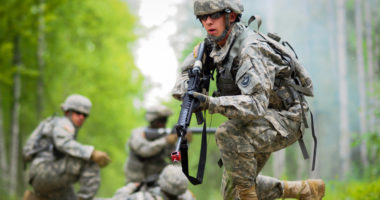Today, there are over 120 armed conflicts around the world, involving over 60 states and 120 non-state armed groups. The majority of these armed conflicts are of a non-international character, the number of which has tripled since the turn of the millennium. To know what rules regulate an armed conflict, there is one crucial first step to take: its classification.
In this post, and in the run-up to the 75th Anniversary of the Geneva Conventions, ICRC Legal Advisers Samit D’Cunha, Tristan Ferraro, and Thomas de Saint Maurice introduce the latest ICRC Opinion Paper, which restates the rules, approaches and interpretations the organization uses to classify and declassify armed conflicts. They argue that, despite the many contemporary challenges, IHL remains today fit-for-purpose for the classification of armed conflicts.
These are trying times for international humanitarian law (IHL). It is not only the number of conflicts that is multiplying, but also the number of actors fighting in these conflicts; and they are doing so in increasingly complex relationships. The number of contexts with a high number of belligerent parties – for example in the Sahel, the Democratic Republic of the Congo, or Myanmar – is higher today than ever before. At times, these parties form coalitions; at other times, they receive support from third-party actors, including other states, through complex political, economic, or military relationships.
Today, many armed conflicts, including in the Democratic Republic of the Congo, Israel and the occupied territories, Myanmar, Russia and Ukraine, Sudan, and many others, have become cradles of immense suffering and humanitarian concern. These are compounded by global and increasingly salient geopolitical tensions.
In this context, it is not only the regulation of conflict which has become increasingly challenging, but also the identification of conflicts as such. The latter challenge, which is the subject of this post, is of fundamental importance, given IHL largely applies only during armed conflicts.
The classification of conflicts and the ICRC’s 2024 Opinion Paper
Common Articles 2 and 3 of the Geneva Conventions, which differentiate between the rules applicable to international and non-international armed conflicts respectively, reflect the value in eschewing “perfection” and “completeness”, notions used (and discarded a few years later) to describe the purpose of the Geneva Convention’s revision in 1929.
Interestingly, “armed conflict” is not precisely defined in either article, nor anywhere else in the Geneva Conventions. Far from being an oversight, this omission suggests the drafters of the 1949 Geneva Conventions privileged the latter’s adaptability. Adaptability plays a central role in ensuring that the Conventions’ application can respond to the changing environments for which they are needed. Indeed, since the adoption of the 1949 Conventions, their application has been predicated on a fact-based analysis to determine when an armed conflict exists – the classification of a conflict. How the notion of armed conflict itself is defined under IHL – through subsequent treaties, state practice, jurisprudence, and doctrine – has over the years adapted the Geneva Conventions to the evolving nature of how armed conflicts are fought.
Since there is no central authority under international law to classify armed conflicts, parties to a conflict must determine themselves the legal framework applicable to their military operations. For its part, the ICRC independently legally classifies situations of violence for the purposes of its work – including working for the understanding, development, and dissemination of IHL as well as urging greater compliance of the law by parties to conflict. For reasons discussed in this post and despite the challenges noted above, the Geneva Conventions – and IHL more broadly – remain today fit-for-purpose for the classification of armed conflicts.
To provide a synopsis of this important work, this year, the ICRC published an Opinion Paper on the notion of armed conflict. The Opinion Paper largely restates established rules, as well as approaches and interpretations used by the ICRC, for the classification and declassification of armed conflicts, including by drawing on previous Challenges Reports as well as the new Commentaries to the 1949 Geneva Conventions. The ICRC published the Opinion Paper acting in its capacity as the guardian of IHL, a complex role that was formally entrusted to it by the international community, including through its international mandate.
This year is not the first time the ICRC published its legal opinion on the notion of armed conflict. In its 2008 Opinion Paper, the ICRC publicly presented the prevailing legal opinion on the definition of IAC and NIAC under IHL. In the 16 years since that publication, new challenges have arisen, requiring the ICRC to further develop and clarify its interpretation of the notion of armed conflict. The challenges posed by contemporary armed conflicts to classification are not insurmountable; IHL continues to adapt to change while maintaining what the Conventions’ drafters were trying to achieve: the broadest possible application of IHL to situations of organized armed violence for which the Conventions were developed, limiting the suffering caused by warfare and alleviating its effects.
The classification and declassification of an armed conflict can be conceptualized as four concrete steps: (1) collecting factual information, (2) analyzing the information for accuracy and completeness, and (3) applying the IHL legal criteria for determining the existence of an armed conflict to those facts, to then (4) draw a conclusion. Iterating the process of classification and declassification over decades, across all regions and contexts of the world, also afford valuable insights with regard to both lessons learned on how the law must be applied to the facts, but also how conflicts have changed over time. It is no surprise, then, that the ICRC is well-positioned to opine on how the classification of contemporary armed conflicts may require further refinement and understanding. These findings, including a selected few presented below, are shared in the Opinion Paper.
Select issues for contemporary international armed conflicts
Regarding international armed conflicts (IACs), for example, two clarifications were important inclusions for the Opinion Paper: first, on the notion of intensity with regard to IACs, and second, on the meaning of occupation.
While there is no specific level of intensity required for the classification of an IAC, it was important to highlight in the Opinion Paper that while even minor skirmishes between states may trigger an IAC, several acts – including, for example, the sale or donation of military equipment to a party to an armed conflict – are not considered a “resort to armed force” for the purposes of IHL applicability. Similarly, while most experts agree that cyber operations having similar physical effects to classic kinetic operations would trigger an IAC, cyber operations do not always have such effects. The law is not yet settled on whether cyber operations only disrupting or disabling the functionality of digital infrastructure trigger an IAC.
In some cases, IACs take the form of occupations. Under IHL, a territory is considered occupied “when it is actually placed under the authority of the hostile army. The occupation extends only to the territory where such authority has been established and can be exercised.” From this definition, a cumulative three-part test to establish authority or, as it is referred to in the legal doctrine, “effective control”, is presented in the 2024 Opinion Paper.
Selected issues for contemporary non-international armed conflicts
Similarly, several issues related to the classification of non-international armed conflicts, or NIACs, were examined in the Opinion Paper. Inter alia, the Opinion Paper looked at the application of the support-based approach, the notion of aggregating intensity, and the geographic scope of application of IHL in NIACs.
When the involvement of a state, an international organization, or an NSAG in a pre-existing NIAC takes the form of military support – for the benefit of one party against another – that has a direct impact on the enemy’s ability to carry out its military operations, including the use of force, intelligence activities (immediately used in military operations), or participation in the planning and coordination of military operations, the involvement might effectively make that supporting entity a co-party while illogically allowing it to avoid responsibility for its IHL obligations and simultaneously claim protection from direct attacks. As a result, as explained in the Opinion Paper, the classical criteria must be complemented by taking a support-based approach to third-party operations in pre-existing NIACs.
In other situations when there is no pre-existing NIAC, several states, organized armed groups, or international organizations may operate in a coalition where there is a clear coordination between these entities. To avoid legal and operational loopholes, the ICRC submits in the Opinion Paper that when multiple organized armed actors maintain a sufficient level of coordination in a coalition, the intensity between each of them and an opposing party may be aggregated when considering whether the threshold of intensity has been reached.
Finally, today, many NIACs around the globe do not take the form of traditional civil wars, but they are nevertheless governed by IHL applicable to NIACs. The territorial scope of NIACs has been the subject of some debate when a conflict spills over into neighbouring territory or in the case of interventions in a foreign state. In these situations, there are cogent legal and humanitarian reasons to argue that IHL applies beyond the territorial state’s borders – the parameters of that extra-territorial application are discussed in the Opinion Paper. On the other hand, in relation to other situations of transnational violence, the ICRC’s position is clear that there cannot exist a conflict of “global dimensions” between a state and an NSAG.
The end of an armed conflict
In defining the notion of armed conflict, the 2024 Opinion Paper not only considers classification, but of course how conflicts are also declassified – that is, when they come to an end. Importantly, declassification is not as simple as applying the criteria for classification in reverse. As with the classification of conflicts, the declassification of conflicts is based on the facts on the ground rather than on political instruments or declarations. For IACs, this means that a conflict comes to an end when there is a general close of military operations – explained in detail in the Opinion Paper. Similarly, a NIAC comes to an end when one of two conditions is reached: either one of the parties to the conflict ceases to exist, or there is a lasting cessation of armed confrontations without a real risk of resumption.
Conclusion
Adaptability does not require reinventing the wheel. Identifying changes remains as important as recognizing that the vast majority of rules – in particular those on classification and declassification – remain the same. Indeed, in a world characterized by increasing polarization between states and the oftentimes casual use of ill-defined notions such as “hybrid threats” and “proxy wars”, it is important to recall that political discourse must not obfuscate the legal classification or declassification of an armed conflict. Armed conflicts are classified, and rules applied, based on the facts on the ground – and the 2024 Opinion Paper presents the ICRC’s view on how this work is done today.
The Opinion Paper does not address every challenge to the classification and declassification of contemporary armed conflicts – several challenges remain, and more will surely come as conflicts continue to evolve. But by implicitly acknowledging the space for the notion of armed conflict to continue to develop over time and emphasizing the inherent adaptability of the Geneva Conventions as illustrated by the malleability of the notion of armed conflict under IHL, the Paper reinforces the key message that even in these trying times, the contemporary application of the law is what we should strive for to be perfect and complete.
See also:
- Jacob Coffelt, Codifying IHL before Lieber and Dunant: the 1820 treaty for the regularization of war, April 4, 2024
- Natalie Klein-Kelly, Karen Loehner, The transmission of information by the ICRC’s Central Tracing Agency in international armed conflicts, February 29, 2024
- Ruben Stewart, Georgia Hinds, Algorithms of war: The use of artificial intelligence in decision making in armed conflict, October 24, 2023
- Melina Fidelis, War, law and humanity: the role of the ICRC in international armed conflicts, February 16, 2023








Comments